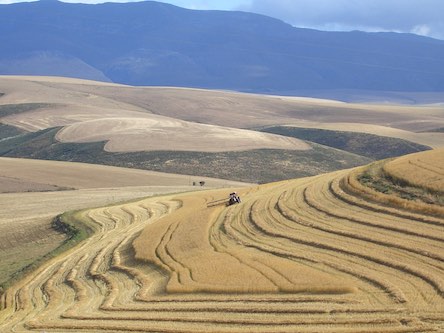
Our entire food system is global. But what might surprise you about the global food system is where crops that are eaten in different regions of the world actually originate.
Most people don’t know that more than 69% of the crops that make up the foundation of national diets originally came from somewhere else: and that “somewhere else” is often a completely different part of the globe.
Not only that, but this globalized food chain has accelerated over the past 50 years when dietary dependence on foreign crops stood at 63%. Also, the crops that are grown in certain parts of the world are also originally from another area of the planet.
Many Americans might assume that our vast Midwestern prairie lands, abundant with farms and endless fields of wheat and corn crops, are the origin point for those products. But a groundbreaking study in 2016 shows that is not the case.
The wheat, barley, chickpeas, and almonds that are staples of the American diet actually originated in the Mediterranean and Asia. U.S. farms are known for growing wheat (originally from the Mediterranean), soybeans (East Asia), and maize (Mexico). One crop that was created in America but that is grown all over the world, from South America to China, is the sunflower. more

Introduced crops, particularly those from the Americas, fueled population explosions. We may not have had the Industrial Revolution without the potato in Northern Europe. Corn drove population growth in Italy and Africa. Cassava/manioc/yuca and the sweet potato did the same throughout the tropics. The Bantu migration in Africa was driven by manioc and corn. The expansion of the slave trade was also a result of large population surpluses in Africa.
Wheat, barley, rye and oats from Europe and rice and plantains (there may have been native plantain, but they were not widely distributed) from Asia made a large impact in the Americas, probably helping to recover from the massive die-off (some say, over 90% within a generation) caused by introduced diseases.
I remember watching a documentary about finding Shangri-la. They claimed an extremely isolated valley in the Himalayas as the site. They were eating boiled potatoes in a cheese sauce flavored with chile peppers. That is a popular recipe in Peru called Papa a la Huancaina. Food for thought.
Peanuts. Goobers or monkey nuts are grown around the globe, but American import law allows less than 1% to come into our country from the outside world.
File that for the next trivia contest you are in.
Look at it also as location diversity.
If a particular crop fails in one location (flood, drought, bugs, early this, late that), there’s usually another location somewhere else in the world that grows the same thing.
All the crops grown around me are A) corn to fill your gas tank and B) soybeans to boost estrogen.
This year my gardening was simplified. About 180 lbs of roma tomatoes, enough for stewed tomatoes 2-3 nights per week in late summer plus 16 1-quart jars, and 2 crops of sugar snap peas, enough for dinner every other night in spring/early summer and late summer/early fall. Peas are still producing, but blight is taking over.
^ My favorite is making tomato soup in quantity and then freezing it. Brightens up ANY winter day, especially with some great Italian bread!
(Damn, now I’m hungry.)
I’m sure dollars have influenced this more than weather. How many acres of the USA has been converted to corn for bullshit ethanol? Ethanol couldn’t exist without Gov’t subsidies top to bottom. Part of the reason gas prices are so high is to make ethanol a viable product. I still haven’t seen an ethanol powered power plant, because it costs more to produce, than it is worth.
How many of these food sources utilize child labor?
Hey mickey moussaoui,
I got a goober question. Years back I was driving through off the beaten track Alabama and Georgia and Florida. At some Gas Station in someplace I stopped for Gas and Coffee and Cigarettes and any long rode trip munchies like Sunflower Seeds or real beef jerky. Anyways, the checkout had a basket of little white paper bags of roasted peanuts for a buck. I snagged 3 or 4 and got back on the road. The nuts got put in the snack pack bag and many miles passed.
Still driving a day or two later, probably in Colorado or someplace around there, I tucked into the first bag. To my surprise these were miniature peanuts. They were like Mini-Me nuts. Never had nuts so small before. But that surprise was amplified when I tasted them. Best Nuts EVER.
Have you ever heard of such a tiny nut making such a flavor impact? Do they have a name?
Tomato Head wants to know.
Thanks mickey
@MJA
Your title reminded me of a book that my Boy Scouts gifted me at the end of our 2 week Philmont backpacking trip.
https://www.amazon.com/What-Bird-Did-That-Drivers/dp/0898154278
.